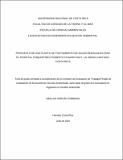| dc.contributor.advisor | Rojas Marín, José Félix | |
| dc.contributor.author | García Zumbado, Ubaldo | |
| dc.date.accessioned | 2020-09-15T01:00:01Z | |
| dc.date.available | 2020-09-15T01:00:01Z | |
| dc.date.issued | 2019 | |
| dc.identifier.uri | http://hdl.handle.net/11056/18144 | |
| dc.description | Tesis para optar al grado de Licenciatura en Ingeniería en Gestión Ambiental. | es_ES |
| dc.description.abstract | Propone el diseño de una planta de tratamiento de aguas residuales para el Hospital Psiquiátrico Roberto Chacón Paut. Se inicia por caracterizar fisicoquímica y microbiológicamente las aguas residuales, con respecto a los parámetros que establece la normativa nacional y aquellos que resultan elementales para el diseño de sistemas de tratamiento. Se comprueba la presencia de algunos contaminantes emergentes en las aguas residuales, principalmente fármacos psiquiátricos. Se escogen tres puntos de muestreo representativos dentro del hospital. Posteriormente, se aplica una metodología de selección óptima de sistemas de tratamiento de aguas residuales y se evalúa la factibilidad técnica de la tecnología escogida, la cual consiste en un reactor secuencial de batch como tratamiento secundario. Finalmente, se lleva a cabo el diseño de la planta que, además del reactor tipo batch y el digestor aerobio de los lodos producidos, involucra un proceso de desbaste para la remoción de sólidos gruesos y moderadamente finos, separación de grasas y aceites, tratamiento terciario basado en humedales artificiales para la remoción de fósforo y algunos contaminantes emergentes, así como un sistema de cloración para la desinfección del efluente hospitalario, previo vertido a cuerpo receptor. | es_ES |
| dc.description.abstract | It proposes the design of a wastewater treatment plant for the Roberto Chacón Paut Psychiatric Hospital. It begins by characterizing the physicochemical and microbiological wastewater, with respect to the parameters established by national regulations and those that are elementary for the design of treatment systems. The presence of some emerging pollutants in the wastewater, mainly psychiatric drugs, is verified. Three representative sampling points are chosen within the hospital. Subsequently, an optimal selection methodology for wastewater treatment systems is applied and the technical feasibility of the chosen technology is evaluated, which consists of a sequential batch reactor as secondary treatment. Finally, the design of the plant is carried out which, in addition to the batch reactor and the aerobic digester of the sludge produced, involves a roughing process for the removal of thick and moderately fine solids, separation of fats and oils, tertiary treatment based on artificial wetlands for the removal of phosphorus and some emerging pollutants, as well as a chlorination system for disinfection of hospital effluent, prior to discharge to the receiving body. | es_ES |
| dc.description.sponsorship | Universidad Nacional, Costa Rica | es_ES |
| dc.language.iso | spa | es_ES |
| dc.publisher | Universidad Nacional, Costa Rica | es_ES |
| dc.rights | Acceso abierto | es_ES |
| dc.rights | Attribution-NonCommercial-NoDerivatives 4.0 Internacional | * |
| dc.rights.uri | http://creativecommons.org/licenses/by-nc-nd/4.0/ | * |
| dc.subject | INGENIERÍA SANITARIA | es_ES |
| dc.subject | EVACUACIÓN DE AGUAS RESIDUALES | es_ES |
| dc.subject | ANÁLISIS DEL AGUA | es_ES |
| dc.subject | CONTAMINACIÓN DEL AGUA | es_ES |
| dc.subject | ADMINISTRACIÓN HOSPITALARIA | es_ES |
| dc.subject | SANITARY ENGINEERING | es_ES |
| dc.subject | WASTEWATER DISCHARGE | es_ES |
| dc.subject | WATER ANALYSIS | es_ES |
| dc.subject | WATER CONTAMINATION | es_ES |
| dc.subject | HOSPITAL ADMINISTRATION | es_ES |
| dc.title | Propuesta de una planta de tratamiento de aguas residuales para el Hospital Psiquiátrico Roberto Chacón Paut, La Unión, Cartago, Costa Rica | es_ES |
| dc.type | http://purl.org/coar/resource_type/c_7a1f | es_ES |
| una.tesis.numero | TESIS 10442 | es_ES |
| dc.description.procedence | Escuela de Ciencias Ambientales | es_ES |


